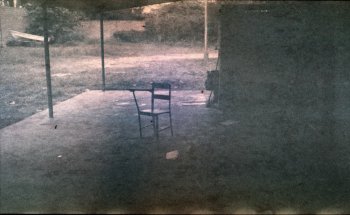How it works
Thirty years ago I spent a year in South America searching for the "real" shamanism; some of that time was spent around the Amazon, almost all of the rest I spent in the Orinoco basin. During that year I shot 27 rolls of slide film. When I returned to the USA I had the idea to leave the film undeveloped for 30 years. I must admit that I didn't necessarily expect that I'd really be able to keep the experiment going, to ensure that the rolls would still be around in 30 years. And part of the concept was that I would not take any special measures to protect the film because the idea was to allow whatever changes might occur, to occur: those changes are the essence of the piece.
The premise
Spirit photography is usually considered controversial even by those sympathetic with the idea. The reason of course is that in the early days of photography some advocates, eager to "prove" something, created fake images of supposed spirits and tried to pass those off as genuine. Today it strikes us as funny that those people didn't seem to think about the possibility that photographic technology would evolve, and that someday the public would be familiar with that technology and would easily see that the images had been faked. The unfortunate side effect of all of that though was that the fakes, even those that were produced by people with good intentions, invited antagonism.
The tacit assumption then is that if we want to revisit this practice of spirit photography, we are obliged to deal with that resistance by offering images that unequivocally prove the existence of something that we imagine to be spiritual. But in fact spirit photography should not concern itself with proving anything. Existence of spirits can never be proven really, because really spirits don't "exist". Or rather, spirits manifest and indeed they even have identifiable features, but that doesn't necessarily mean that they exist in the normal sense. This is not to say that a spirit is something imaginary, something strictly mental. It is not. Spirits can have effects that are mental, but they can also have real-world, coincidental effects.
Rather than trying to capture a specific kind of image then, spirit photography should be about creating an occasion, a situation, a mechanism that allows for the possibility that a spirit influence might be captured on film, without making assumptions about exactly what form that should take. Fortunately there are ways to approach this. In fact the idea can be found in many cultures in the form of divination. Divination is pretty much exactly the sort of thing we are looking for here: a mechanism through which spirit influence can be made apparent. Of the Essence could as well be considered a form of divination as an experiment in spirit photography.
It's the possibility of "coincidental" real-world effects that is the focus of this piece. No assumptions are made, but the possibility exists, and that is enough.
Also see in links A Fish Clinging to Water a solo spoken word piece about other South American adventures.
-- Sam Ashley
Exhibition is held within Fotograf Festival # 4 – "seeing is believing".







